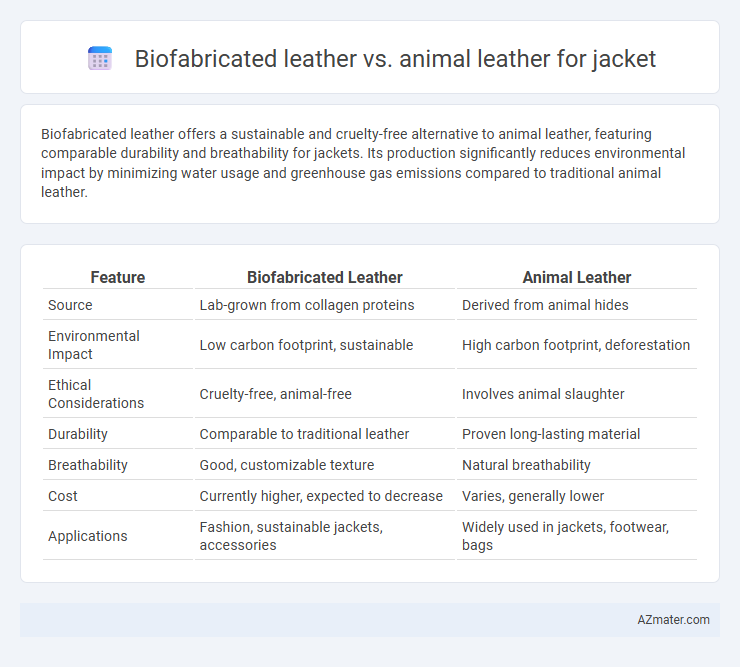Biofabricated leather offers a sustainable and cruelty-free alternative to animal leather, featuring comparable durability and breathability for jackets. Its production significantly reduces environmental impact by minimizing water usage and greenhouse gas emissions compared to traditional animal leather.
Table of Comparison
| Feature | Biofabricated Leather | Animal Leather |
|---|---|---|
| Source | Lab-grown from collagen proteins | Derived from animal hides |
| Environmental Impact | Low carbon footprint, sustainable | High carbon footprint, deforestation |
| Ethical Considerations | Cruelty-free, animal-free | Involves animal slaughter |
| Durability | Comparable to traditional leather | Proven long-lasting material |
| Breathability | Good, customizable texture | Natural breathability |
| Cost | Currently higher, expected to decrease | Varies, generally lower |
| Applications | Fashion, sustainable jackets, accessories | Widely used in jackets, footwear, bags |
Introduction to Biofabricated Leather and Animal Leather
Biofabricated leather is produced using cultured animal cells to create a sustainable, cruelty-free alternative that mimics the texture and durability of traditional leather. Animal leather, derived from the tanned hides of livestock, remains valued for its natural strength, breathability, and aging properties that enhance the jacket's character over time. Both materials offer unique qualities, with biofabricated leather emphasizing environmental impact reduction and animal leather rooted in centuries of craftsmanship.
Sustainability: Environmental Impact Compared
Biofabricated leather significantly reduces carbon emissions and water usage compared to traditional animal leather production, which is responsible for high methane emissions and extensive land degradation. The biofabrication process utilizes lab-grown materials that eliminate the need for livestock farming, drastically lowering deforestation and pollution associated with tanning chemicals. As a sustainable alternative, biofabricated leather offers a lower environmental footprint while maintaining durability and aesthetic qualities essential for jackets.
Material Properties and Durability
Biofabricated leather offers enhanced sustainability and uniform material properties compared to animal leather, featuring consistent texture and reduced environmental impact. Its durability rivals that of traditional animal leather, with improved resistance to wear, tearing, and water exposure due to advanced bioengineering processes. These characteristics make biofabricated leather increasingly suitable for high-quality jacket production, providing long-lasting performance with ethical manufacturing advantages.
Ethical Considerations and Animal Welfare
Biofabricated leather offers a sustainable alternative to traditional animal leather by eliminating the need for animal slaughter, significantly reducing ethical concerns associated with animal welfare. Unlike conventional leather production, which involves raising and killing livestock under often inhumane conditions, biofabricated leather is produced through cellular agriculture, minimizing animal suffering and promoting cruelty-free fashion. This innovative material supports ethical consumer choices by addressing the environmental impact and animal rights issues inherent in traditional leather jacket manufacturing.
Production Processes: Traditional vs Innovative Methods
Biofabricated leather is produced through cutting-edge biotechnology involving cultured cells and plant-based materials, reducing the reliance on animal farming and chemical tanning processes. Traditional animal leather is derived from livestock hides, undergoing extensive tanning and finishing techniques that often involve hazardous chemicals and significant environmental impact. Innovative methods in biofabrication promote sustainability by minimizing water usage, greenhouse gas emissions, and toxic waste compared to the resource-intensive production of conventional animal leather for jackets.
Aesthetic Appeal and Customization Options
Biofabricated leather offers unique aesthetic appeal with its ability to mimic natural textures while allowing precise control over color, pattern, and finish, enabling highly personalized jacket designs. Animal leather provides a classic, rich texture and patina that develops over time, valued for its authentic and timeless look. Customization options in biofabricated leather extend to sustainable innovations and experimental styles that are difficult to achieve with traditional animal leather.
Performance: Comfort and Wearability
Biofabricated leather offers superior breathability and flexibility compared to traditional animal leather, enhancing overall comfort in jackets. Its lightweight and moisture-wicking properties reduce heat retention, making it ideal for prolonged wear in various climates. Animal leather, while durable and abrasion-resistant, tends to be heavier and less adaptable to movement, potentially compromising comfort during extended use.
Cost Analysis and Market Availability
Biofabricated leather jackets typically command higher prices due to advanced production methods and limited manufacturing scale, making them less affordable than traditional animal leather options. Animal leather remains widely available in global markets, benefiting from established supply chains and mass production, which drives down costs and ensures consistent product availability. As biofabricated leather technology matures and scales up, costs are expected to decrease, potentially closing the affordability gap and expanding market presence.
Consumer Perception and Adoption
Biofabricated leather appeals to eco-conscious consumers seeking sustainable alternatives to traditional animal leather, driven by concerns over animal welfare and environmental impact. Many buyers associate animal leather with durability and luxury, but growing awareness of ethical and ecological issues shifts preference toward biofabricated options. Market adoption accelerates as brands increase transparency and innovate in texture and quality to match or exceed conventional leather standards.
Future Prospects and Industry Trends
Biofabricated leather offers a sustainable alternative to traditional animal leather by reducing environmental impact through lower water usage and carbon emissions, appealing to eco-conscious consumers and luxury brands. Advances in biotechnology and material science are driving innovations that enhance durability and texture, making biofabricated leather increasingly competitive in the jacket market. Industry trends indicate a growing shift towards cruelty-free and ethical fashion, with major brands investing in biofabricated materials to meet demand for sustainable, high-performance outerwear.

Infographic: Biofabricated leather vs Animal leather for Jacket
 azmater.com
azmater.com